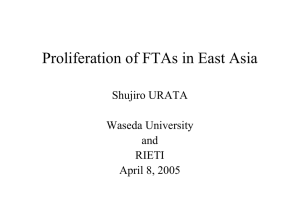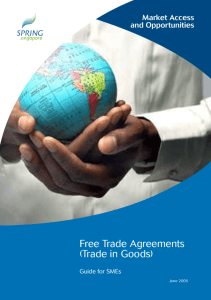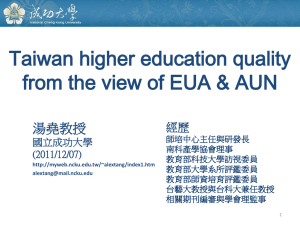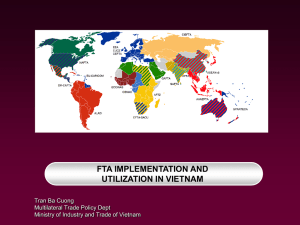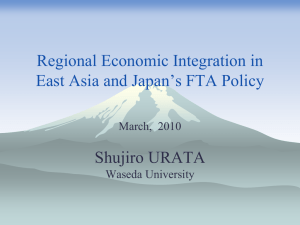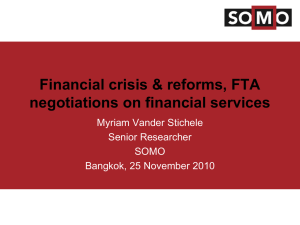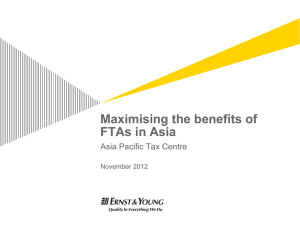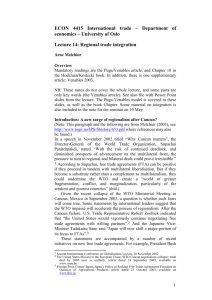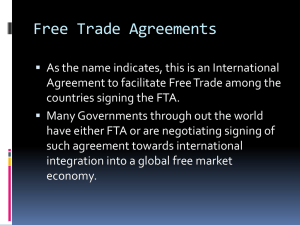Prof Urata presentation
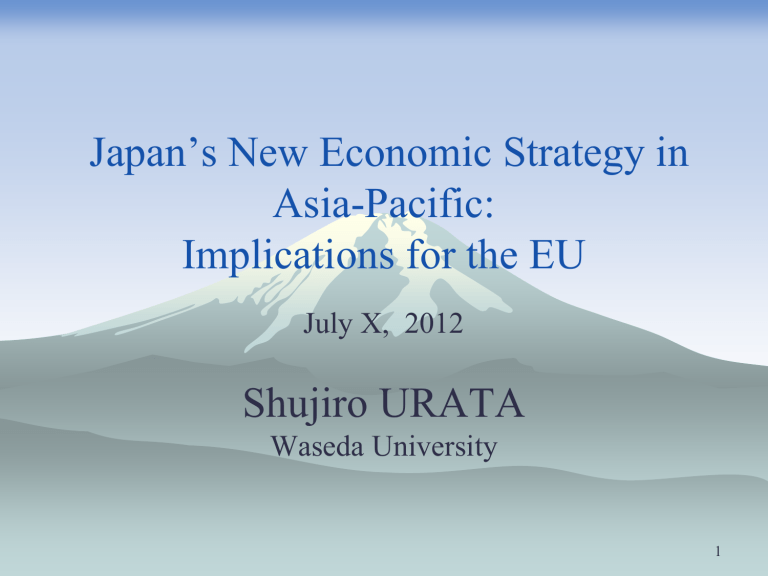
Japan’s New Economic Strategy in
Asia-Pacific:
Implications for the EU
July X, 2012
Shujiro URATA
Waseda University
1
Contents
I. Japan’s Economic Situation
II. High Economic Growth and Regional
Economic Integration in Asia-Pacific
III. Japan’s New Economic Strategy in Asia-
Pacific
IV. Japan-EU EPA/FTA
V. Concluding Remarks
2
1. Japan’s Economic Situation
Current situation
Low economic growth
Recovering from the Eastern Japan Disaster (March 11,
2011)
Closed economy
Future prospects
Declining and aging population
Declining savings rate
Increasing government debt
Challenge for achieving economic growth
Increase productivity
Increase economic interaction with growing Asia
Solutions
New Economic Strategy in Asia-Pacific
Japan-EU EPA
3
GDP Growth Rates (%)
4
GDP
5
Trade-GDP Ratios (%)
6
80 000
60 000
40 000
20 000
0
1,000
140 000
120 000
100 000
65-
15-64
0-14
Japan’s Declining Population
7
%
Gross Domestic Savings (% of GDP)
40
35
30
25
20
15
10
5
0
1990 1991 1992 1993 1994 1995 1996 1997 1998 1999 2000 2001 2002 2003 2004 2005 2006 2007 2008 2009 2010
8
250
%
France
Italy
Canada
Government Debt-GDP Ratios (%)
Japan
US
UK
Germany
200
150
100
50
0
1995 1996 1997 1998 1999 2000 2001 2002 2003 2004 2005 2006 2007 2008 2009 2010 2011
9
II. High Economic Growth and Regional Economic
Integration in Asia-Pacific
Market-driven Regional Economic Integration
High economic growth achieved by rapid expansion of foreign trade and foreign direct investment (FDI)
Advances in regional economic integration
Expansion of trade and FDI in machinery sector
(electronic machinery, transportation machinery)
Increase in parts and components trade
Fragmentation strategy by multinational corporations: formation of regional production networks
Liberalization of trade and FDI policies
10
Total Trade (Exports+Imports) :
EU, East Asia and North America
11
Intra-regional Trade Dependence (%)
12
Intra-regional Trade Ratio (%)
13
Shares of East Asia’s Trade with Regions (%)
14
Share of Parts and Components in
Intra-regional Trade (%)
15
Declining Tariff Rates
20.0
10.0
60.0
%
50.0
40.0
30.0
C hina
Indonesia
M alaysia
P hilippines
Thailand
0.0
1981 1982 1983 1984 1985 1986 1987 1988 1989 1990 1991 1992 1993 1994 1995 1996 1997 1998 1999 2000 2001 2002 2003 2004 2005 2006 2007
16
Trade Liberalization: Declining Tariff Rates (%)
Japan
China
1988
2007
1992
Korea
2007
1988
2007
Indonesia 1989
2007
Malaysia 1988
2007
Philippines1988
2007
Singapore 1989
2007
Thailand 1989
2006
Australia 1991
2007
Primary Manufactured goods goods
8.3
11.4
35.1
3.5
2.9
40.6
4.2
4.2
40.4
9.0
19.3
20.8
18.2
6.6
10.9
2.8
29.9
6.0
0.2
0.2
30.0
13.6
3.0
0.9
8.9
18.6
6.6
19.2
5.8
14.9
6.5
27.9
4.8
0.4
0.0
39.0
10.4
14.1
3.1
10.8
12.8
2.8
8.9
18.6
8.5
19.2
5.9
14.5
5.9
28.3
5.0
0.4
0.0
38.5
17
Emergence of institution-driven regional economic integration
Rapid expansion of free trade agreements (FTAs) in East
Asia in the 21 st century
FTA (free trade agreement): free trade (elimination, reduction of tariff and non-tariff barriers among FTA members)
In East Asia ASEAN has become a hub of FTAs:
5 ASEAN+1 FTAs have been implemented
4 initiatives have been proposed for region-wide FTA:
ASEAN+3 (East Asia FTA), ASEAN+6 (CEPEA),
ASEAN++ (RCEP), Free Trade Area of Asia-Pacific
(FTAAP)
The US has become active in region-wide FTA: Trans-
Pacific Partnership (TPP)
18
FTAs in East Asia (December 2011)
Bangkok Treaty (1976)
AFTA (1992)
Thailand-NZ (2005) Japan-Brunei (2008)
Singapore-India (2005) China-NZ (2008)
Singapore-NZ (2001) Korea-Singapore (2006) Taiwan-Nicaragua (2008)
Japan-Singapore (2002) Japan-Malaysia (2006) Singapore-Peru (2009)
Singapore-Australia (2003) Korea-EFTA (2006)
Singapore-EFTA (2003) China-Chile (2006)
China-Singapore (2009)
Japan-Switzerland (2009)
Singapore-US (2004)
Korea-Chile (2004)
China-Hong Kong (2004) Japan-Chile (2007)
China-Macao (2004) Japan-Thailand (2007)
Taiwan-Panama (2004)
Korea-ASEAN (2006) Japan-Vietnam (2009)
Singapore-Panama (2006) India-ASEAN (2010)
China-Pakistan (2007)
ASEAN-Australia-NZ (2010)
China-Peru (2010)
China-Taiwan (2010)
Singapore-Jordan (2004) Malaysia-Pakistan (2007) Korea-EU (2011)
Japan-Mexico (2005)
China-ASEAN (2005)
Japan-Philippines (2008)
Japan-ASEAN (2008)
Japan-India (2011)
China-Consta Rica (2011)
Thailand-Australia (2005) Japan-Indonesia (2008) Korea-Peru (2011)
19
FTAAP: Free Trade Area of the Asia-Pacific
Efforts under various frameworks
ASEAN+3 ( EAFTA )
( ASEAN + JP, CH, KR )
ASEAN+6 ( CEPEA)
( ASEAN+JP, CH, KR, IND, AUS, NZ )
TPP
Current members
Malaysia
Singapore
Brunei
US
A
Peru
TPP
Australia
New Zealand
Chile
RCEP
Establishment of 3 working groups (for trade in goods, services and investment) in 2012
Japan-China-Korea
Launch of negotiations in 2012
FTAAP (APEC)
Russia
China
Korea Japan
CH.
CH. Taipei
Brunei
Malaysia
Singapore
Vietnam
Philippines
Indonesia PNG
Australia
New Zealand
Canada
US
Mexico
Peru
Chile
(Source: METI, Japan)
20
7
Motives behind FTAs in East Asia
Increase market access through trade and FDI
Rapid expansion of FTAs in the world
Promote domestic reform
Rivalry between East Asian countries
Motives behind region-wide FTAs in East Asia
Financial crisis in 1997-98
Global financial crisis in 2008-
Overcome Spaghetti bowl effect
Establish region-wide single production base and unified market 21
Rapidly Increasing FTAs in the World
22
Expected Impacts of FTAs
Trade and FDI expansion between and among FTA members
Economic growth
Economic Obstacles to FTAs
Opposition from non-competitive sectors
23
IV. Japan’s New Economic Strategy in Asia-Pacific
Comprehensive Economic Partnership
Agreement (EPA) including trade and FDI liberalization, facilitation, economic cooperation
Export infrastructure such as transportation system and water supply system including hard and soft infrastructure
Export agricultural products
Attracting foreign direct investment inflows and high skilled personnel
Attracting foreign tourists
etc.
24
Japan’s FTAs (EPAs): June 2012
Implemented
Singapore November 2002
Mexico April 2005
Malaysia July 2006
Chile
Thailand
Indonesia
Brunei
Philippines
ASEAN
Switzerland
Vietnam
India
Peru
Share in
Japan's trade
(2010)
September 2007
November 2007
July 2008
July 2008
December 2008
December 2008
September 2009
October 2009
August 2011
March 2012
18.7%
Under negotiation
Korea
GCC
Australia
Mongolia
20.0%
Under study
ASEAN+3
ASEAN+6
China, Japan, Korea
EU
TPP
Canada
Colombia
25
Motives
Expand export market for Japanese firms
Improve investment environment for
Japanese firms
Obtain energy and natural resources
Promote structural reform in Japan
Improve and establish good relationship
Provide economic assistance to developing countries
Opposition
Agriculture, fishery
26
Impacts of FTAs on GDP (%): Simulation Results
Japan
China
Korea
Indonesia
Malaysia
Philippines
Singapore
Thailand
Vietnam
Other Southeast Asia
Australia
New Nealand
India
Hong Kong
Taiwan
NAFTA
EU15
Rest of the World
ASEAN+3 ASEAN+6
FTA
0.44
4.72
3.55
3.94
8.62
6.28
4.24
7.02
9.67
2.91
-0.09
-0.06
-0.1
0
-0.08
-0.01
-0.01
-0.06
-0.08
FTA
0.54
4.84
3.71
4.14
9
6.52
4.42
7.32
9.92
2.95
1.35
1.87
3.45
-0.01
-0.01
-0.01
-0.01
ASEAN
ASEAN+3
ASEAN+6
5.67
1.93
1.68
5.89
2.05
2.11
27
High Tariff Agricultural Products (%)
B eef
D airy products
W heat
B arley
Sugar
P ork
C orn
Starch
P eanuts
R ice
Konnyaku potato
0 200 400 600 800 1000 1200 1400 1600 1800
28
Japan-EU EPA
Developments
Scoping exercise for Japan-EU EPA began in May
2011 and ended in May 2012
Waiting for the negotiations to begin
Expected benefits
Strengthen economic and non-economic relations
Expand exports and FDI not only bilaterally but with other countries, contributing to economic growth: EU
GDP to increase 0.14 percent, Japan’s GDP 0.31 percent (Copenhagen Economics, 2009)
Contribute to rule-making in the global economic system
29
Japan’s Trading Partners: 2010 (%)
Others
25%
China
21%
Hong Kong
Malaysia
3%
3%
Saudi Arabia
3%
Indonesia
3%
Thailand
4%
Australia
4%
Taiwan
5%
Korea
6%
EU
10%
US
13%
30
Japan’s Foreign Direct Investment Destinations: 2011 (%)
31
Japan’s Position
Eager to start negotiations with an interest in strengthening economic relations and overcoming disadvantageous position in the EU market vis-à-vis
Korean firms: EU tariffs--cars (10%), flat screen TVs
(14%), microwave ovens (5%) etc.
EU position
Somewhat hesitant in starting negotiations immediately (in response to Japan’s inability to join
TPP negotiations?)
Eager to open Japan’s government procurement market and reduce non-tariff measures, in order to expand trade and FDI 32
V. Concluding Remarks
Faced with many difficult challenges, Japan has to open up its economy and carry out structural reforms, in order to achieve economic growth or to maintain high living standard, to contribute to economic growth in Asia-Pacific and in the world.
WTO liberalization being stalled, free trade agreements
(FTAs) are second-best solution for promotion of trade and
FDI
Japan can gain a lot from FTAs not only in East Asia but also with countries in other parts of the world such as the
US, the EU, and Latin American countries
33
Japan should play active roles in establishing regionwide FTAs: RCEP, TPP by liberalizing its market
Then expand these FTAs by merging with other
FTAs, leading to global trade liberalization
FTAs face opposition from non-competitive sectors
For Japan, trade liberalization in agriculture faces strong opposition
Various measures including gradual phase-in liberalization, and temporary assistance to negatively affected workers can moderate the negative impacts during the process of transition
Need strong political leadership to promote FTAs
34

